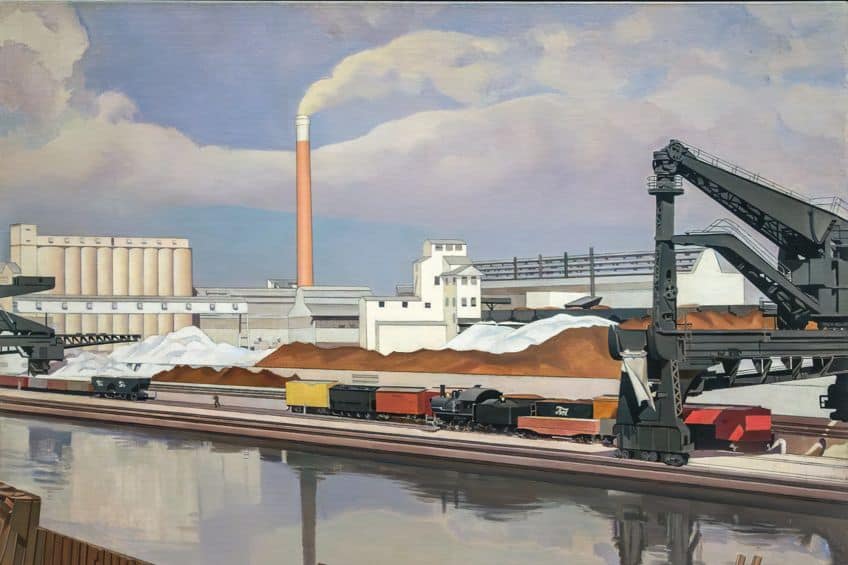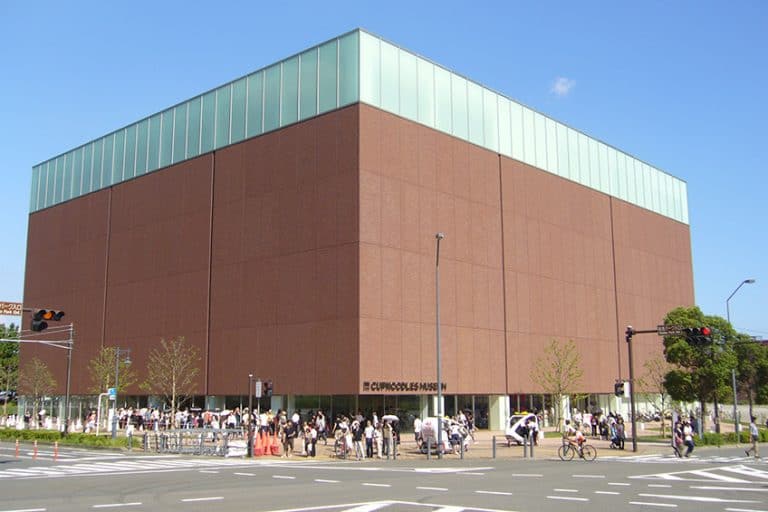Pollution in Art – Climate Activism Through Artistic Expression
Pollution in art has become a poignant and powerful theme, reflecting society’s growing awareness of environmental issues and the urgent need for sustainable practices. Artists across various mediums have explored the detrimental effects of pollution on nature and humanity, using their work to critique industrialization, advocate for ecological preservation, and evoke emotional responses from their audiences. This intersection of art and environmentalism not only raises awareness but also fosters a deeper understanding of our collective responsibility towards the planet. Through vivid imagery, provocative installations, and innovative use of materials, these artworks challenge viewers to confront the pervasive impact of pollution and inspire action for a cleaner, healthier world.
Key Takeaways
- Art reflects pollution throughout history and its evolution.
- Pollution-themed artworks provoke critical thinking and raise awareness.
- Modern artists use innovative methods to address environmental issues.
Historical Context and Evolution
Pollution, a pressing issue of our time, has found its reflection and critique in the realm of art across various periods. From Monet capturing the industrial haze over the Thames to contemporary artists addressing climate change, the evolution of pollution in art is both poignant and telling. Artists have not only mirrored environmental degradation but have also used their works to raise awareness and prompt societal change.

The Industrial Revolution brought about significant environmental changes, which were captured artistically by figures like Claude Monet. In contrast, modern artists like Mary Mattingly confront pollution through interactive and informative installations. This artistic dialogue highlights an ongoing concern about the environment and engages audiences in a deeper conversation about our planet’s future. Pollution in art stretches from historical depictions to modern-day innovations. Whether using found materials or creating large-scale installations, artists across eras have consistently highlighted the impact of pollution.
Their works serve as a bridge between art and activism, urging viewers to reflect on their role in environmental stewardship.
Influence of Pollution on Art Movements
During the Industrial Revolution, pollution became an integral part of urban landscapes. Factories and coal plants in cities like London emitted vast amounts of soot and smoke, transforming the atmosphere. This transformation is evident in the works of Claude Monet. His paintings, such as The Thames below Westminster, depict murky skylines tinged with industrial haze. This era marked a shift towards Realism, capturing the gritty reality of urban life. Fast forward to the 20th century, and pollution continued to shape art movements. Umberto Boccioni and the Futurists, driven by industrial themes, portrayed chaotic, smog-filled cityscapes. The Environmental Art Movement emerged later, with artists like Agnes Denes using art to challenge and raise awareness about environmental degradation.
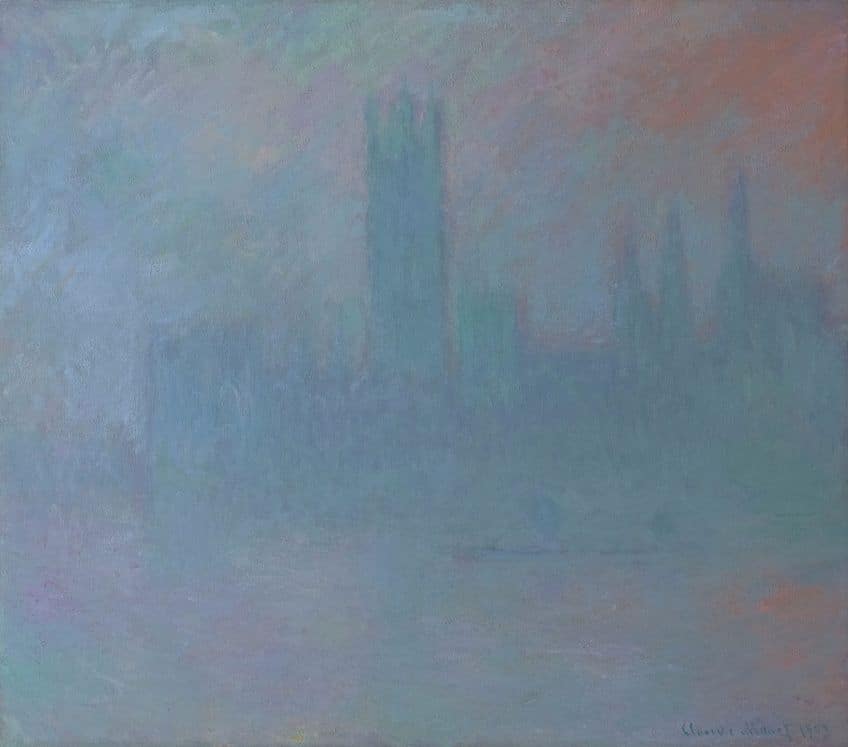
Iconic Artists and Pollution
Claude Monet frequently depicted the smoggy environments of industrialized London. His impressionistic techniques highlighted the interplay between light and polluted air, creating a unique atmospheric effect. Paintings like The Thames below Westminster and Houses of Parliament vividly illustrate his fascination with fog and industrial haze. In the modern era, artists like Agnes Denes pushed boundaries with works such as Wheatfield, a Confrontation, directly confronting environmental issues through art. These pieces go beyond aesthetics, merging art with activism.
Monet’s early works laid the groundwork, but contemporary artists expanded on his legacy, addressing the persistent issue of pollution through various media and styles.
Through the Decades: Pollution and Art Movements
Art has historically reflected societal changes, with pollution becoming a significant theme during major industrial and technological transformations. This section explores how different art movements from the Industrial Revolution to Earthworks have depicted pollution.

The Industrial Revolution
The Industrial Revolution, spanning the late 18th to early 19th centuries, dramatically altered the landscape of cities. Artists like J.M.W. Turner captured this transformation. His painting, Rain, Steam and Speed (1844), illustrates the impact of industrialization, with hazy atmospheres caused by the era’s pollution.
Similarly, Claude Monet’s works such as The Thames below Westminster (1871) depicted the smog-filled skies of industrial cities.
Impressionism
Impressionist artists like Monet and Whistler often depicted the atmospheric effects of pollution in their works. The hazy and diffused light seen in Monet’s Impression, Sunrise (1872) can be partially attributed to air pollution. This movement’s focus was on capturing the transient effects of light and atmosphere, which were often influenced by the era’s industrial emissions.

Futurism
In the early 20th century, Futurism, led by artists like Umberto Boccioni, embraced the themes of speed, technology, and industrial advancement. Pollution was a byproduct of the industrial dynamism they celebrated.
Boccioni’s works reflect the chaotic energy of modern life, which included the industrial smog and pollution intertwined with technological progress.
Precisionism
Precisionism emerged in the United States during the 1920s and 1930s, characterized by an admiration for industrial subjects and the clean lines of machinery. Artists such as Charles Sheeler highlighted the stark beauty of factories and urban landscapes. While mostly emphasizing the positive aspects of industrialization, these works also subtly acknowledge the environmental impact through their detailed representations of industrial environments.

Earthworks
Earthworks, or Land Art, arose in the 1960s and 1970s as a reaction to industrialization, focusing on the relationship between art and the environment. Artists like Robert Smithson used natural landscapes to create art that often addressed environmental concerns, including pollution. Smithson’s Spiral Jetty (1970) reflects a response to the ecological changes and industrial impacts on natural settings.
These art movements collectively highlight how artists have responded to and represented the evolving issue of pollution, each reflecting the complexities of their respective eras.
Modern Artistic Responses to Pollution
Many contemporary artists incorporate themes of pollution into their work, using a variety of mediums to address environmental issues and inspire change. They create art that not only raises awareness but also provokes action and reflects the human impact on ecosystems.

Environmental Art as a Platform for Action
Environmental Art has become a significant platform for addressing pollution and ecological concerns. Artists like Agnes Denes use large-scale projects to highlight environmental degradation. For instance, her work, Wheatfield – A Confrontation, transformed a landfill into a wheat field in Manhattan, symbolizing the wastefulness of urban development. Chris Jordan’s photography series, Albatross, illustrates the severe effects of plastic waste on marine life.
His stark images of birds affected by plastic ingestion bring attention to the problem of single-use plastics.
Sculpture and Land Art Innovations
Sculpture and Land Art push the boundaries of traditional art by using natural and often reclaimed materials. Robert Smithson’s Spiral Jetty is an iconic site-specific work that engages with natural processes and environmental change over time. Washed Ashore, an organization creating art from plastic debris, brings awareness to ocean pollution. Their sculptures, like giant marine animals made from plastic bottles, serve as striking reminders of the pervasiveness of plastic waste in oceans. Andy Goldsworthy is another key figure whose ephemera-based Land Art, made from materials like leaves, stones, and ice, emphasizes the transient nature of the environment.

Visual Art Narrating Pollution
Visual artists use a mix of media to tell the story of pollution’s impact. Katherine Boland creates works referencing natural disasters and climate change. Her collection displayed in “OUTPUT: ART AFTER FIRE” is born out of the devastating Australian bushfires, reflecting on the ongoing climate crisis. Artists also rely on public installations to engage communities. Mary Mattingly’s Swale, a floating garden in New York, addresses urban food deserts while encouraging communal involvement in sustainability practices.
In summary, modern artists are using a diverse range of methods to focus on the theme of pollution, effectively linking environmental issues with artistic expression to both inform and inspire their audiences.
Artwork Examples of Pollution in Art
Art has long been a medium through which artists address environmental concerns. Several well-known works illustrate how pollution has been depicted and critiqued over the years.

The Thames below Westminster (1871) by Claude Monet
Claude Monet’s The Thames below Westminster captures the Industrial Revolution’s impact on London. With smog-covered skies and murky waters, Monet paints a city transformed by industrial pollutants. The dimness and atmospheric haze underscore the period’s environmental degradation.
Monet uses a muted palette to evoke the somber mood, capturing both the beauty and pollution of urban progress in his impressionistic style.
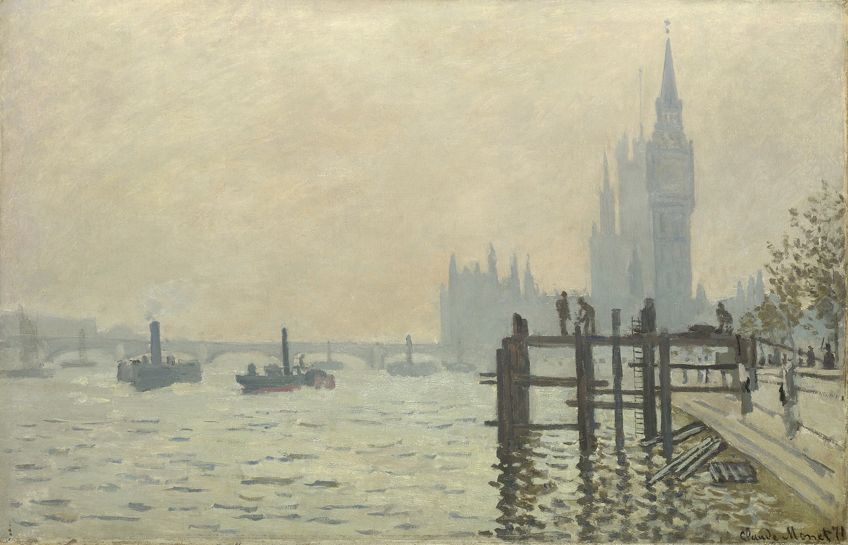
States of Mind I: The Farewells (1911) by Umberto Boccioni
Umberto Boccioni’s States of Mind I: The Farewells portrays the emotional and physical pollution caused by industrialization. The fractured, dynamic forms illustrate the chaos of train travel and the polluted air from steam engines.
Boccioni’s use of Futurist techniques highlights the overwhelming presence of technology and its disruptive impact on human experiences and the environment.
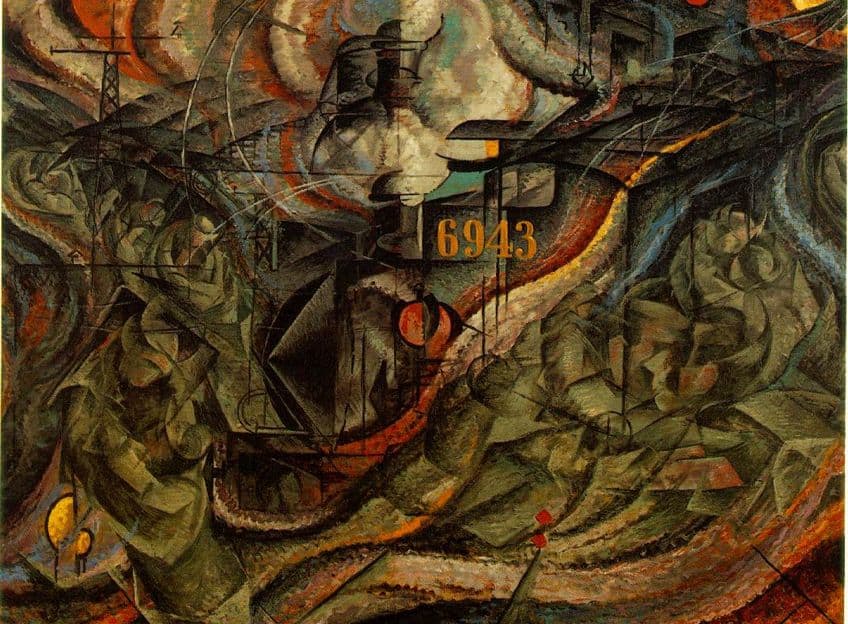
American Landscape (1930) by Charles Sheeler
In Charles Sheeler’s American Landscape, the focus shifts to the industrial pollution of urban America. The painting’s clean lines and geometric forms convey an orderly, yet sterile depiction of a factory scene. Smoke rising from chimneys and the absence of natural elements emphasize the dominance of industrial structures over the natural landscape.
This work comments on the environmental costs of industrial progress.
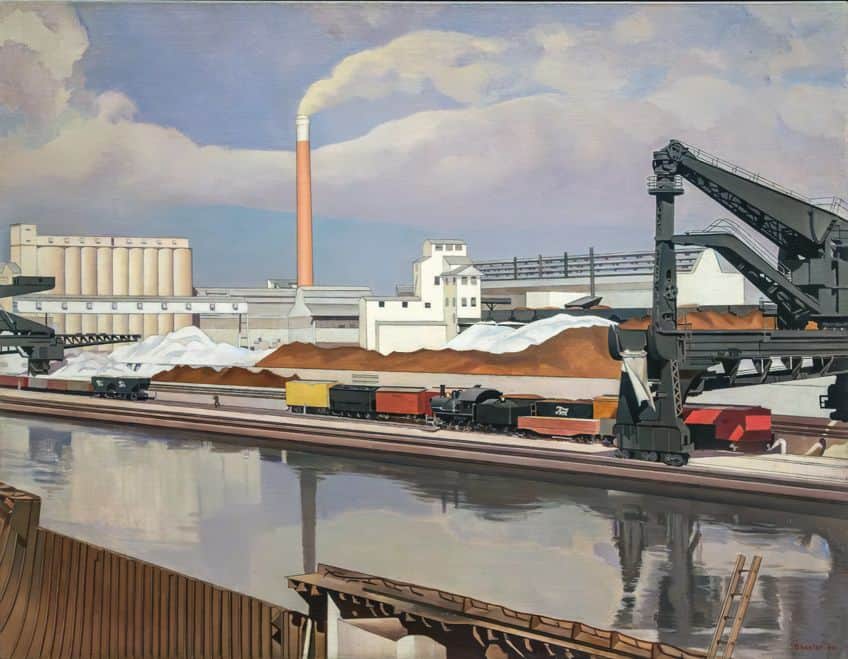
Spiral Jetty (1970) by Robert Smithson
Robert Smithson’s Spiral Jetty engages with natural pollution through its medium and location. Constructed from mud, salt crystals, and basalt rocks on the Great Salt Lake, the piece becomes part of its environment. The fluctuating water levels and salt concentration transform the jetty over time, reflecting the natural processes of decay and renewal.
Smithson’s work invites contemplation on ecological and environmental changes.
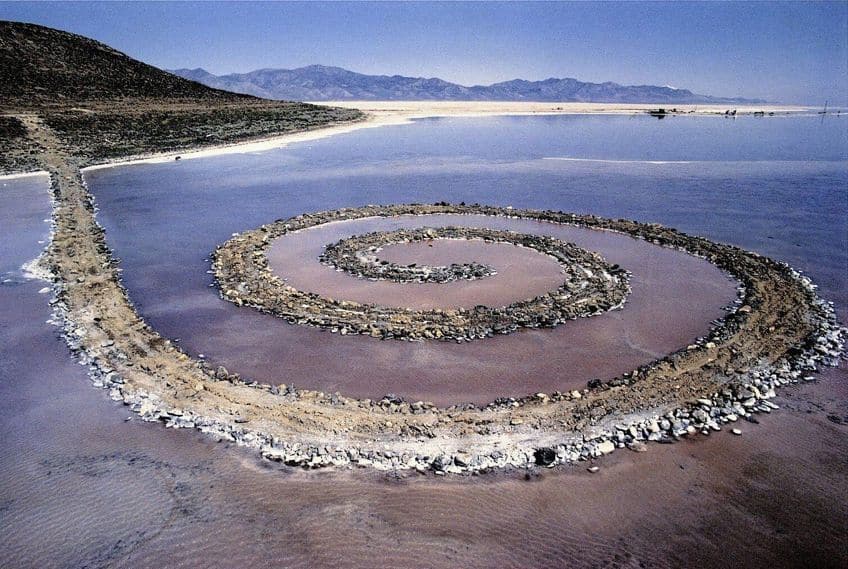
Last Turn—Your Turn (1991) by Robert Rauschenberg
Robert Rauschenberg’s Last Turn—Your Turn uses discarded materials to comment on waste and consumerism. Utilizing items like tires, traffic signs, and metal scraps, Rauschenberg highlights society’s throwaway culture. The assemblage serves as a critique of environmental degradation caused by waste.
His innovative use of found objects underscores the urgent need for awareness and action on pollution issues.
Intersection of Pollution, Art, and Awareness
Artists have been leveraging their creative talents to address pressing environmental issues, using their work as both a catalyst for climate action and a tool for education. This section explores how art not only raises awareness about pollution but also encourages community involvement and change. Artists like Michael Pinsky and projects such as the Pollution Pods exemplify how art can stimulate climate action.
Pollution Pods create an immersive experience that highlights the varying air quality in different cities, urging viewers to advocate for cleaner air.
With initiatives like the Helen Frankenthaler Foundation’s grants, artists receive support to create works that address climate issues. These grants empower emerging artists to produce meaningful pieces that engage the public with the urgency of climate action. Earthworks, such as Robert Smithson’s Spiral Jetty, place art directly in polluted environments. These pieces draw attention to the consequences of environmental neglect and inspire activism.
The Role of Art in Education and Nonprofit Initiatives
Art plays a crucial role in educational endeavors and nonprofit initiatives focused on environmental awareness. Programs often collaborate with artists to create visual aids that explain complex topics like climate change and pollution more effectively. Nonprofits like ART 2030 use art campaigns to advocate for a healthier planet, linking artistic expression with sustainability goals.

Educational institutions and organizations, including the Drifters Project, incorporate art into their curriculums to teach students about the impacts of pollution on endangered species and Mother Nature. By integrating art into these programs, educational and nonprofit initiatives ensure that the message of urgency reaches a wider audience, fostering a deeper understanding and commitment to environmental protection.
The exploration of pollution in art serves as a compelling testament to the transformative power of creativity in addressing critical environmental issues. By capturing the stark realities and intricate consequences of pollution, artists have successfully amplified the discourse surrounding ecological sustainability and the urgent need for environmental stewardship. These artistic endeavors not only reflect the anxieties of our time but also inspire change by fostering a deeper emotional connection to the natural world. As we move forward, the continued fusion of art and environmental advocacy will remain crucial in galvanizing public awareness and motivating collective action towards a more sustainable future.
Frequently Asked Questions
What Type of Artwork Typically Represents Environmental Pollution?
Environmental pollution is commonly depicted through mixed media installations, sculptures made from recycled materials, and paintings. These artworks often use discarded and polluted materials to physically represent the nature of pollution.
How Do Artists Highlight the Effects of Pollution Through Their Work?
Artists often use vivid imagery, contrasting colors, and tactile textures to draw attention to pollution’s impact. They may incorporate data visualization, such as in Andrea Polli’s Particle Falls, which shows real-time air quality data through changing light patterns.
What Environmental Issues Are Commonly Addressed by Contemporary Artists?
Contemporary artists focus on issues like plastic waste, air and water pollution, deforestation, and climate change. Their works aim to raise awareness and inspire action by depicting the adverse effects on ecosystems and human health.
What Is the Term for Art That Focuses on Environmental Themes?
Art that centers on environmental themes is known as environmental art. It emerged in the 1960s and emphasizes the interconnectedness of humans and nature, often using natural or waste materials to convey messages about environmental conservation and degradation.
Isabella studied at the University of Cape Town in South Africa and graduated with a Bachelor of Arts majoring in English Literature & Language and Psychology. Throughout her undergraduate years, she took Art History as an additional subject and absolutely loved it. Building on from her art history knowledge that began in high school, art has always been a particular area of fascination for her. From learning about artworks previously unknown to her, or sharpening her existing understanding of specific works, the ability to continue learning within this interesting sphere excites her greatly.
Her focal points of interest in art history encompass profiling specific artists and art movements, as it is these areas where she is able to really dig deep into the rich narrative of the art world. Additionally, she particularly enjoys exploring the different artistic styles of the 20th century, as well as the important impact that female artists have had on the development of art history.
Learn more about Isabella Meyer and the Art in Context Team.
Cite this Article
Isabella, Meyer, “Pollution in Art – Climate Activism Through Artistic Expression.” Art in Context. July 27, 2024. URL: https://artincontext.org/pollution-in-art/
Meyer, I. (2024, 27 July). Pollution in Art – Climate Activism Through Artistic Expression. Art in Context. https://artincontext.org/pollution-in-art/
Meyer, Isabella. “Pollution in Art – Climate Activism Through Artistic Expression.” Art in Context, July 27, 2024. https://artincontext.org/pollution-in-art/.


